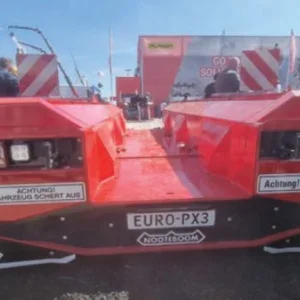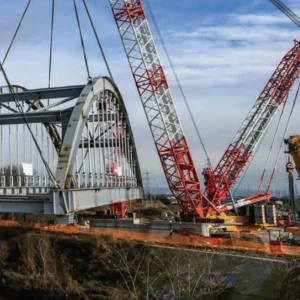You are 40m above the quayside overlooking a large container ship from which you are about to lift a 20ft container. You have no idea what’s inside – it could be just a consignment of canned food; or it could be a rare vintage Ferrari.
As you lift the container you feel the cab tilt forwards slightly as the crane flexes under the load. Carefully you lift the box and start to trolley back. You notice that you are gripping the levers too hard – your knuckles are white. You relax your grip and quickly wipe the sweat from your brow with the back of your hand. You are nervous. You have never done this before.
As the box comes back towards you, you suddenly realise it’s too low. You try to hoist the container to clear of the ship’s side but it’s no good – with collision now inevitable, you shut your eyes and brace yourself for the impact…
Well done! Your career as a crane operator has got off to a promising start. Okay, you misjudged the last bit but there’s no harm done – this was just a simulation, after all.
Allowing trainee crane operators to make dangerous and expensive mistakes like this was completely unthinkable until the advent of crane simulators. But now an instructor can place his student in the most hazardous situations, with the worst weather and visibility conditions imaginable, and get them used to dealing with emergencies with a clear head. And complete novices can be fast-tracked through their training, learning from their mistakes without leaving a trail of destruction in their wake.
Airline pilots have benefited from the use of simulators for many years. More recently, though, this virtual technology has been applied in other environments, where training in the real world is either too expensive or fraught with risk. The offshore industry is one example – simulators are used to train the operators of directional drilling rigs and remotely operated sub-sea vehicles (ROVs). In the mining industry, simulators are used to train people to drive huge rigid dump-trucks weighing hundreds of tonnes. And ship’s helmsmen are trained to sail the biggest supertankers with bridge simulators.
In the crane sector, too, the use of simulators has focused on maritime applications and in many cases has developed from these other applications. Hitec-O, GlobalSim and Ship Analytics, arguably the world’s top three suppliers of crane simulator technology, all focus on marine applications. Other areas of the crane industry have been slower to adopt simulator training, mainly because the difficulties involved in training in offshore and dockside cranes are more acute. A crawler crane or tower crane, for example, can be rigged in a yard and used comparatively safely for operator training.
‘Products from companies like Hitec, Ship Analytics and GlobalSim are “high-end” turnkey simulators sold to the marine industry where the costs of cranes are so high, and where operator productivity is so important,’ says Paul Freedman, president of Canadian firm Simlog, a relative newcomer to the sector. Founded in 1999, Montreal-based Simlog has its roots in the forestry industry; its core products are harvesting and logging machinery simulators, but it has recently turned its attention to the crane industry.
‘Here at Simlog we are working in a brand new, and very different corner of the crane industry, with products costing orders of magnitude less than marine crane simulators and designed for set-up on the customer’s PC,’ says Freedman.
‘There are not many big container handling cranes in the world compared with other types of crane. They are big and very complex and extremely expensive. Land-based mobiles are probably the most common type of crane and therefore can be built and sold relatively cheaply,’ he says. It follows that few owners or users of mobile cranes can justify spending the sort of money on a simulator that a port authority or a major training institute can afford.
To get some idea of the cost of a top-range crane simulator you have to look at the type of equipment recently acquired by the Shanghai Port Authority in China, or Rotterdam’s Shipping & Transport College (STC) in the Netherlands.
STC is currently commissioning a pair of simulators supplied by Norwegian virtual reality specialist Hitec-O. Based on its existing HiCrane system, one of these new machines will feature full 360° panoramic view of unrivalled realism, thanks to a special projection dome covering the simulator’s cab.
Tom Bremer, director of European sales at Hitec-O, says this system is the first of its type in the world. Although the software is PC-based, the system requires no fewer than 13 separate PCs, each driving its own graphics projector.
‘We have had 22 programmers working on this project,” says Bremer. ‘The simulator can be programmed for training in straddle carriers, ship-to-shore gantry cranes or portal cranes, interfacing with six different types of ship.’
The operator can visualise large areas of the Port of Rotterdam – Hitec’s programmers visited the dock and walked around the actual site to help with their visualisations.
The second simulator at Rotterdam is a relatively modest machine, utilising only five PCs and doing without the projector dome. But together, the systems will cost the customer $3m.
Last year, Hitec’s rival Ship Analytics won the contract to supply Shanghai with a new dockside crane simulator. ‘This is the first Chinese contract for a crane simulator and it is a big contract for us. China is a very important market,’ says systems engineer Dan Lamothe.
The system at Shanghai was developed under the Digitran brand name; Ship Analytics took over Digitran in 1997. The system, like Hitec’s, is PC-driven and features a full-scale crane cab mounted on a motion platform. This gives 6° motion to simulate the pitch and yaw motion of a crane in operation. The system uses a main host computer, which synthesises the crane operations, linked to a number of interface computers, each of which drives an image projector. Nine interchangeable modules are available to adapt the simulator for different crane types, and the cab is equipped with interchangeable control panels.
Shanghai has taken four modules: ship-to-shore gantry cranes, straddle carriers, rubber tyred gantries and ship gantries. Although reluctant to reveal the value of this contract, Ship Analytics says that as the technology develops and more customers recognise the benefits of using simulators, the cost will come down. ‘With every simulator we produce, the cheaper the price,’ says Lamothe.
Shanghai is typical of the sort of customer Hitec and Ship Analytics are pursuing. As trade between China and the rest of the world increases, the demand for crane operators rises. ‘In the USA, the workforce is ageing. The sector is also very much run by the unions and it is difficult to get new people into the industry. But in Shanghai, they are taking them straight from school and crane simulators help to prepare students for real life in a crane cab,’ Lamothe says.
These expensive simulators, with all the bells and whistles, still appeal mainly to the maritime sector. ‘Demand is so strong that we haven’t tapped into the construction market,’ says Lamothe, even though Ship Analytics can offer tower crane, truck crane and crawler crane versions of its dock pedestal crane simulator. ‘The construction industry is an option, but not one we’re directly addressing yet,’ he says.
This leaves the field wide open to the likes of Simlog. Paul Freedman agrees that the land-based market is quite different to the maritime one – there are far more potential customers for a start. He is aiming at crane rental firms, crane users, consultants and training firms, and he is pricing his product accordingly. For $2,500 you can buy the Simlog Personal Mobile Crane Simulator, a CD-ROM which will run on your desktop PC requiring only the addition of a couple of standard off-the-shelf joystick controls.
It is not the same true-to-life mock-up environment offered by the likes of Hitec, Ship Analytics or GlobalSim, but that does not matter, Freedman argues.
‘We believe that almost all of simulation’s value is in the software sophistication. That is, the kinds of tasks to be performed, the ways in which your task execution is measured and how the tasks are organised,’ he says.
‘We are far ahead of what the other simulator companies are doing, who continue to concentrate on building crane ‘replicators’ – the crane does ‘X’ so the simulator does ‘X’ – instead of building tools to help train new operators and tools to help evaluate and improve the skills of existing operators.’
Panoramic 360° displays are fine, but not necessary, Freedman believes. ‘You can only look one way at a time, and with our system you can select different views with a joystick button.’
Freedman believes that the adoption of the CCO operator certification programme in the USA will stimulate demand for the Simlog system. ‘The CCO practical exam component was designed to evaluate the generic skills required to operate most any crane and that’s why the practical exam tasks, for example, serve as generic tasks for Simlog to build our simulated tasks around.’
Freedman says he knows of no other crane simulators currently targeting his market – not to mention selling at his price. The majority, he says, aim at the high-cost market served by companies like Hitec, Ship Analytics and GlobalSim. If Paul Freedman is right, though, it cannot be long before he is up against some tough competition at the more affordable end of the simulator market.
Who’s doing what in the world of simulators?
The crane simulator industry is a young one, less than 10 years old. It is still the preserve of a very few specialised companies, although research bodies and industry groups are now actively working on new simulator systems.
Hitec-O of Stavanger, Norway, started out as a specialist in offshore drilling control systems. In the mid-1990s it developed a simulator for training the operators of remote control drilling rigs. Its first crane simulator emerged in 1999.
Hitec now offers a range of crane simulators for dockside and offshore crane types under the HiCrane brand name. These are designed to give trainees hands-on experience of crane operation under normal, abnormal and emergency conditions. Based on object-oriented software, the system can be customised to suit different users and can interface to different types of crane cab. Hitec offers a gantry crane, offshore crane and straddle carrier versions of the system, each using an actual crane cab mounted on a motion platform with computer generated images projected onto screens in front of the cab windows. The software provides a detailed three dimensional representation of the crane and its surroundings, allowing the operator to move freely around the scene. Bad weather, poor visibility and heavy seas can be simulated, with the motion platform providing physical feedback to enhance the realism of the experience.
The HiCrane Portable uses software based on the HiCrane full size simulator running on a powerful PC and displayed on a standard 17 inch monitor. To lend realism to the system, force-feedback joysticks are used and the simulator has a realistic sound system.
GlobalSim, formerly KQ Corporation, has one of the broadest ranges of crane simulators currently available. Like most other leading producers, its simulators are tailored mainly for the offshore and dockside industries. Under the Masterlift trade mark, GlobalSim produces simulators for straddle carriers, dock gantry cranes, shipboard pedestal cranes, port mobile jib cranes and barge derricks. Simulators for reach stackers, container forklifts and rubber-tyred gantries are planned.
GlobalSim claims to offer realistic simulators a prices that are affordable for ‘virtually every port and terminal material handling organisation’. The company says that it has achieved this by abandoning non-standard computers and adopting a modular strategy that maximises the capabilities of modern PCs and allows the system to be periodically upgraded.
GlobalSim has recently begun to address the construction market through collaboration with crane manufacturer Manitowoc. Based on a prototype built for the US Army in the late 1990s, this system is based around the EPIC controls of a 250t capacity Manitowoc crawler crane and has been used by Manitowoc for operator training for the past two years. Visitors to major trade shows like Bauma or ConExpo in recent years may have seen this simulator on Manitowoc’s stand. Costing about US$120,000 this simulator is considerably cheaper than most dockside and offshore versions.
Ship Analytics started producing crane simulators after acquiring specialist firm Digitran in 1997. Digitran was one of the first companies to supply simulators into the port sector, and this has given Ship Analytics a head start in the industry.
One of the very first users of Digitran crane simulators was the Pacific Maritime Association at Tacoma, Washington, USA. This is a sophisticated system capable of simulating a variety of different port crane types and, according to Ship Analytics systems engineer Dan Lamothe, is ‘just like the real world’.
Canadian firm Simlog is addressing the mobile crane market with a low-cost PC-based simulator. Aimed at crane rental firms, the system uses simple off-the-shelf computer joysticks and speakers to replicate the crane operation.
The system puts the operator at the controls of a typical mobile hydraulic crane, with telescopic boom, fly jib and a variety of loads and hooblocks. Instrument readings, such as boom angle, length, height and radius, are displayed along with a simulated load moment indicator. The operator’s viewpoint, shown on a 17 inch video monitor, can be switched to allow the operator track the position of the load, boom tip or target position.
Also in Canada, the Operating Engineers Training Institute of Ontario (OETIO) has collaborated with the Integrated Manufacturing Technology Institute (IMTI) of the National Research Council of Canada to develop a prototype crane simulator based around a Grove mobile crane cab.
Training for mobile crane operators in Ontario requires 6,000 hours of on-the-job training and two six-week periods in the classroom and on actual cranes. OETIO hopes the simulator will supplement the actual ‘seat-time’ in the training programme.
One of the few companies to investigate the use of simulators for electric overhead travelling cranes is P&H Morris Material Handling Inc. Working with GlobalSim, the company has produced a training simulator that will enable operators to practice lifting and placing a variety of loads within the factory environment. Designed to give realistic hands-on experience, the system is based on a Pentium III processor with 128 MB of RAM running on a Windows operating system. The visual display is a full colour uninterrupted scene covering a 60° horizontal, 45° vertical, field of view.






